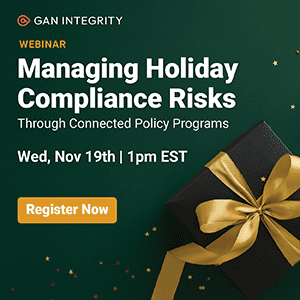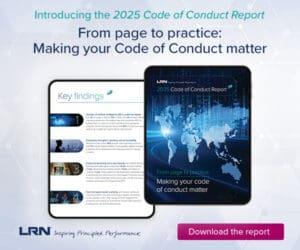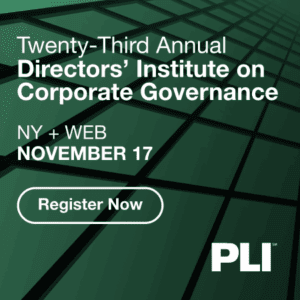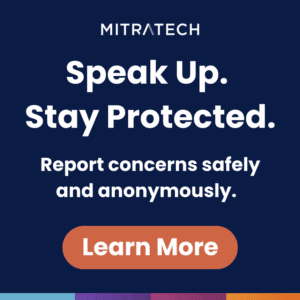CCI staff share recent surveys, reports and analysis on risk, compliance, governance, infosec and leadership issues. Share details of your survey with us: editor@corporatecomplianceinsights.com.
55% of corporate directors say least 1 board colleague should be replaced
A majority of public company directors — 55% — say at least one of their fellow board members should be replaced, according to a PwC survey of over 600 public company directors. This marks a six-percentage-point increase from 2024 and represents the highest level of boardroom dissatisfaction recorded in the survey’s nearly 20-year history.
The primary driver is a perceived lack of meaningful contribution to board discussions, cited by 41% of directors who want a colleague replaced, the survey found. Other factors include long tenure leading to diminished performance (34%), lack of necessary expertise (21%) and interaction styles that negatively impact board dynamics (20%). Despite this recognition of underperformance, many boards remain reluctant to act, citing collegiality and personal relationships (25%), the awkwardness of replacement processes (21%) and proximity to mandatory retirement (19%) as reasons for inaction.
Other key findings:
- Most directors — 78% — say their board’s assessment process does not provide a complete picture of overall performance, and 73% of boards do not conduct individual director assessments.
- Boards continue to prioritize traditional expertise when recruiting, with industry knowledge (34%), financial acumen (27%) and operational experience (22%) remaining the top three areas.
- Only 35% of directors say their boards have incorporated AI into their oversight roles, with 43% citing keeping pace with AI developments as their top concern.
AI, contract analytics emerge as urgent priorities for general counsel
AI and contract analytics have captured the attention of general counsel as urgent strategic priorities in the second half of 2025, according to a Gartner survey of 104 general counsel which found that 36% of GCs are focused on adopting AI, building AI skills in their departments or improving AI risk management in their organizations.
Additionally, 9% said they want to use advanced contract analytics and technology tools to better manage contract risks and reduce costs. These two topics have emerged alongside perennial priorities like evaluating the business impact of the rapidly evolving legal and regulatory environment and increasing the speed of assessing emerging risks.
Despite growing interest in contract analytics, adoption remains challenging. More than a third of general counsel — 37% — report relatively low confidence in using advanced contract analytics tools.
S&P 500 companies spent average of $15M on CEO succession costs in 2024
S&P 500 companies making top-level executive changes paid out an average of close to $15 million in cash plus equity sign-on bonuses in 2024, a 109% jump from the previous year, according to Diligent Market Intelligence compensation data.
The surge in succession costs comes as CEO turnover accelerated, with 68 S&P 500 CEOs departing their roles in 2024 — a 30% increase from 2023. The pace of turnover has increased by over 50% compared to 2015. Median CEO compensation in the index rose 8% year-over-year to reach $17.1 million in 2024, with the value of unvested equity driving the make-whole component of sign-on bonuses higher.
Nike handed $22.3 million to new CEO Elliott Hill, while Starbucks awarded Brian Niccol $19.3 million to secure his appointment. Severance pay added another layer of cost, with the index paying out an average of $2.9 million in cash to departing CEOs in 2024 and $383 million since 2020.
Other key findings:
- The average tenure for an S&P 500 CEO currently stands at seven years, with the average age at 59.
- Long-term incentive grants for executives continue to increase, and as the stock market performs well, the value of unvested equity driving sign-on bonuses is likely to continue growing.
- Former FMC Corp. CEO Mark Douglas received one of the largest cash severance payments in the index at $5.8 million, while PTC’s James Heppelmann and former Starbucks boss Laxman Narasimhan received packages valued at close to $5.1 million.
AI leaders outpace laggards with double the revenue growth and 40% more cost savings
Companies at the forefront of AI innovation are pulling away from their competitors, achieving twice the revenue growth and 40% greater cost reductions in areas where they apply AI, according to a BCG survey of 1,250 senior executives and AI decision makers across nine industries.
The study identifies three categories of AI maturity: 5% of companies qualify as “future-built,” systematically building cutting-edge AI capabilities and generating substantial value; 35% are “scalers,” scaling up efforts and beginning to generate value; and 60% are “laggards,” reporting minimal revenue and cost gains without proper capabilities for scaling AI. Future-built firms plan to spend more than twice as much on AI compared to laggards in 2025, and they achieve 1.7x revenue growth, 3.6x three-year total shareholder return and 1.6x EBIT margin compared to laggards.
Other key findings:
- Future-built companies allocate 15% of their AI budgets to agentic AI, with a third of these firms using agents, compared with 12% of scalers and almost none of laggards.
- Across sectors, 70% of AI’s potential value is concentrated in core business functions such as sales and marketing, manufacturing, supply chain and pricing, with IT accounting for 13% of AI value.
- Software, telecommunications and payments and fintech companies lead in AI maturity, while fashion and luxury, chemicals and construction remain at the lower end of the curve.
Many US employers report preparedness gap as they navigate modern labor landscape
Employers are facing a preparedness gap as they navigate an evolving labor relations landscape, with only 9% of non-unionized employers feeling very prepared to effectively respond to union organizing activity, according to an executive survey by the law firm Littler.
The survey found that one in four employers whose workplaces are not fully unionized report experiencing organizing activity over the past two years. Among employers with unionized employees, just 18% feel very prepared to handle more aggressive collective bargaining tactics, such as strikes, walkouts or coordinated corporate campaigns. This comes as 42% of respondents with unionized employees say union leaders have become more confrontational and aggressive over the past year.
Most employers surveyed that do not have unionized employees — 85% — believe that if a union organizing drive were held today, less than 30% of their employee base would sign a union authorization card. However, the report suggests these businesses may be underestimating employee willingness to consider joining a union.
Other key findings:
- Less than half of respondents at organizations with some unionized employees have developed a strike or business disruption contingency plan (44%) or prepared strategic and economic analyses to assist with bargaining (34%).
- Aside from pay and benefits, the leading drivers for employee support of organizing efforts include work/life balance (38%), desire for input into business decisions (31%) and job security (29%).
- Nearly half of respondents — 49% — say the growing number of Gen Z employees in the workforce has given rise to a greater desire among employees to have input into strategic business decisions.
91% of organizations believe sensitive data should be allowed in AI training despite privacy concerns
Organizations are grappling with contradictory views on AI data privacy, with 91% believing sensitive data should be allowed in AI training while 78% express high concern about theft or breach of model training data, according to a Perforce survey of 280 enterprise leaders.
The paradox revealed in the tech company’s survey highlights a lack of understanding that sensitive data allowed into an AI model can never be removed or secured. In response to these concerns, 86% of organizations surveyed are planning to invest in AI data privacy solutions over the next one to two years, the survey found.
The survey also reveals troubling trends around data exposures in non-production environments. Organizations reporting data breaches or theft in software development, AI and analytics environments reached 60% — an 11% increase from the previous year. Despite the known threat landscape, 84% of organizations surveyed are still allowing data compliance exceptions in non-production environments, creating significant vulnerabilities.











